|
|
|
 |
|
|
|
|
|
|
|
Devoils Lane |
|
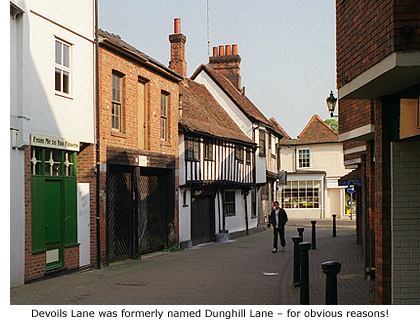 Originally part of the medieval town this small thoroughfare is said to have once been called Dunghill Lane, the name supposedly given because dung carts from the market place parked here. Originally part of the medieval town this small thoroughfare is said to have once been called Dunghill Lane, the name supposedly given because dung carts from the market place parked here.
This may be partly true, though it seems more likely the name was derived from the fact that dung was heaped here when the stables of the Black Lion Inn were cleaned out. Thankfully, the name didn't stick!
The present name 'Devoils Lane' is equally unusual and its origin equally debated. Popular belief has it that it was derived from the surname of a person who either owned property or lived in the lane in the early 18th century. The first mention I can find of Devoils Lane is in Kelly's Directory 1846, at which time the following three tradesmen are listed: James Winterborn, Carpenter and coffee house; Fred Flindall, Tinman & Brazier, and Robert Burton, Smithy.
Street and place names were, and still are, generally named after people or are descriptive of use and surroundings. There is certainly a French feel to the name Devoil and it may well stem from the surname de Voil. This in turn may derive from a family who once traded in the market place and made or dealt in fabrics, more especially voile. Voile is French for veil, descriptive of a thin semi-transparent material made of cotton, wool, or silk, and most often used as lightweight clothing for women or for curtains. Wool voile is called 'Voile de Laine', which may well have been Anglicised to Devoils Lane.
In contrast to the 20th century shops on the eastern side of this narrow lane that are part of the Jackson Square development, the buildings on its western side are 16th and 19th century. The large, three-storey Victorian building at the end of the lane, currently occupied by offices, a Building Society and a book shop, was the town's first purpose-built post office designed by renowned local architect George Pritchett FSA.
Erected in 1890, it is thought that Pritchett incorporated into the construction a timber-framed house that already occupied the site. Later that same year the post office was modified by local builder Joseph Glasscock who installed one of the country's first hydraulic lifts here. This was used to carry mail between the first floor sorting office and the street below where mail carts delivered and collected. Entrance to the post office was at the top of the stone steps leading to Market Square - a large doorway with ornate stone surround and the Royal Arms mounted in the portico.
Elizabeth Millard, the town's Postmistress since 1872 (previously at Bridge Street), continued her role until retirement in 1897. The post office remained here until 1921 and was then relocated to new premises at South Street – ironically, on the site of a previous post office that operated between 1874 and 1876 (See Guide 15). MORE PICTURES
|
|
|
|
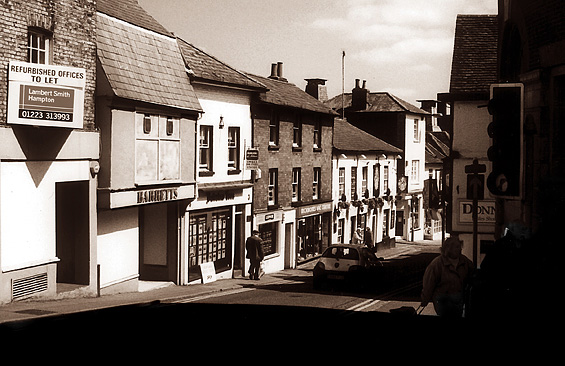 |
|
Threat to burn down the town of Bishop's Stortford
|
|
|
|
Late on the night of Thursday 24 March 1825, a fire was discovered in a downstairs room of the White Horse Inn at North Street. Fortunately, the flames didn't take hold and little damage was done. But on 4 April, between eleven and twelve that night, the smell of burning alerted the landlord to yet another fire in the same room. Again the flames were extinguished before the fire could take hold.
The fires were obviously the work of an arsonist but no reason could be found as to why the White Horse had been targeted. Perhaps frustrated by his failed attempts, the following night the culprit turned his attention to a carpenter's shop in Hockerill with more success. The building was burned to the ground, as was an adjoining barn containing corn that was owned by Vestry member, Robert Cole.
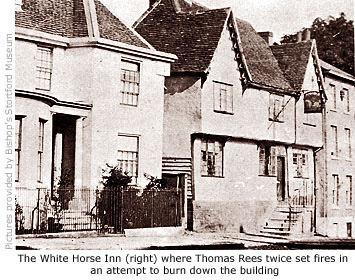 Understandably, the fires caused great alarm in the town, and on 6 April the town crier summoned vestry members to a parish meeting. A committee of eleven worthy citizens was formed and met daily with local magistrates. They organised a subscription whereby £500 was raised as a reward for information leading to a conviction, and a vigilante commission patrolled the town every night. No other fires were detected but on 10 April a threatening letter, written on cartridge paper and addressed to Joseph Taylor on the committe, was left at the North Street post office. It read thus: Understandably, the fires caused great alarm in the town, and on 6 April the town crier summoned vestry members to a parish meeting. A committee of eleven worthy citizens was formed and met daily with local magistrates. They organised a subscription whereby £500 was raised as a reward for information leading to a conviction, and a vigilante commission patrolled the town every night. No other fires were detected but on 10 April a threatening letter, written on cartridge paper and addressed to Joseph Taylor on the committe, was left at the North Street post office. It read thus:
'Revenge is sweet, we defy your police, or your £500. We are strong – you are weak; if Searle and Dunnage do not come home, Stortford shall be laid in ashes. I am their captain and leader, and we are sworn to revenge. I alone am possessed of a secret to fire any premises at a hundred yards distance, so watch on.'
The letter went on to say that three members of the committee had 'made themselves too busy' and that they would be sent to paradise as soon as possible – meaning they would be killed. Searle and Dunnage were two men from Bridge Street in the town, who had been committed to Hertford Gaol accused of stealing rabbits.
The death threats included in the letter added a new dimension to the drama. With no county police force at that time, the committee summoned the help of investigating officers from Bow Street in London. They immediately questioned family and friends of Searle and Dunnage but concluded they did not have the literacy required to write such a letter.
On 17 April the arsonist struck again, this time at a woollen drapery shop in North Street owned by William Francis. He, his wife and family of six daughters and one son lived above the shop, as did several live-in servants. In the early hours of the morning, Francis's neighbour, Joseph Bruce, was woken by his daughter who had heard the crackling of fire. Discovering sparks coming from Francis's woodshed in the backyard, he raised the alarm and woke the Francis household. As he did so he noticed 20 year-old Thomas Rees, the son of William Rees who lived on the other side of the Francis premises, run from an alley dressed only in his trousers and a nightcap. One of Francis's daughters, Sarah, looking from her window to see what the commotion was, also saw Thomas Rees who by now was waving his arms frantically and shouting that her house was on fire.
As William Francis gathered together his family ready to flee to safety a servant at the Star Inn in Bridge Street, George Bush, was already racing to get the fire engine. The Francis family and their servants all escaped unharmed and the fire was quickly extinguished.
During the investigation carried out by the Bow Street officer, J.J. Smith, and members of the committee who had originally summoned his help, it soon became apparent that separate fires had been started within the premises and in outside buildings. Fortunately, though, the arsonist had proved incompetent at his work. Wheat straw, rosin or turpentine had been used to kindle the fires but because they'd been set in the wrong places they hadn't spread. Had they done so, then the Francis family and their servants could well have been lost in the blaze. In addition to the fire it was also discovered that four silver spoons had been stolen from the kitchen.
The layout of the properties led the investigators to believe that the arsonist must have entered the premises of William Francis from an adjoining property. On the northern side was William Rees, a shoemaker (Thomas's father), and on the south side lived Joseph Bruce, a druggist. Behind, to the east, was the stable of the Star Inn surrounded by an eight foot high wall topped with spikes. (This area today is the site of Barclays Bank and a restaurant near to the corner of North Street and Bridge Street)
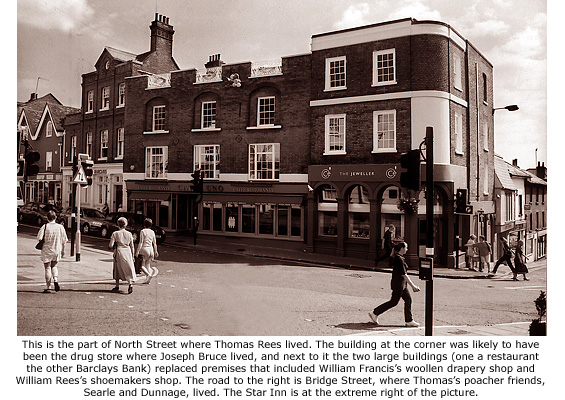
Further investigation revealed that a shed in Rees's backyard abutted the adjoining fence of Mr Francis's backyard, and that a partition of loose boards inside could easily have been removed to allow access between the two properties. Also found at Rees's property were shards of glass similar to that of the outside washhouse that was torched, a large tub of rosin, and fragments of wheat straw. The latter items, however, were commonly used by shoemakers and were not evidence enough to arrest Thomas Rees.
The following evening John Turner, a servant of William Gee, a solicitor, discovered a second letter near the chancel of St Michael's church. It read:
'Devils, tremble: this is only the beginning: before one week is at an end you shall see such things as were never yet seen in Stortford. Devils, believe and tremble: dare you reject our proffered peace! dare you reject our mercy! woe be to three of Stortford! Pray send that lurcher home to his kennel in the lower hells on the back slums: £500 shall never bribe one of us to open our mouths, except it is to chaunt forth – Fire! Fire! Fire! Stortford flames shall reach the sky. N.B. Read, mark, believe, and tremble.'
(The reference to the 'lurcher' was taken to mean the Bow Street officer, and the 'lower hells on the back slums' referred to London)
Prior to John Turner finding the letter, Rees had been seen in the vicinity of St Michael's churchyard. When solicitor William Gee eventually saw the letter, the investigators concluded they now had sufficient evidence to arrest Thomas Rees. He was charged with arson, burglary and issuing threatening letters, and remanded at Hertford Gaol.
At 8am on 14 July at Hertford Summer Assizes, Thomas Rees appeared before Mr Baron Graham to answer the charges. By all accounts Thomas was respectably dressed. A green frock coat with velvet collar was matched with light trousers and striped waistcoat, and around his neck he wore a white cravat, fixed in place by a large brooch. He also wore black gloves and carried a bunch of lavender. His demeanor was calm and relaxed. Messrs Andrews, Broderick and Adolphus appeared for the prosecution, Messrs Jessop, Price and Law for the defence.
As the evidence for the prosecution unfolded, the jury also heard that while Rees had been in Hertford Gaol he had confessed his guilt to a fellow prisoner, Francis Anderson. The two men had subsequently argued, and Anderson later related Rees' confession to the Prison Governor. Rees then approached another prisoner by the name of Carter and tried to bribe him to say that Anderson was lying. Carter refused.
The prosecution then called their witnesses. Elizabeth Sheppherd, servant to Joseph Bruce, the druggist, told how she had been on the way to the privy between ten and eleven o'clock that night and saw Thomas Rees with a ladder dressed only in trousers and wearing a nightcap. When he saw her he said 'I'm looking for a bedfellow, Betsy.' To which she replied rather sharply, 'Then you must find one!'
Mr J.H. Mullinger, printer and stationer of North Street, testified that the watermark on the cartridge paper the letters had been written on was identical to that previously sold by him to Thomas Rees. This evidence meant little though, as such paper was commonly used by shoemakers to produce patterns.
Next up was James Bush, the son of a servant employed at the Star Inn, and John Fowler who worked for Rees's father. Both told of how Rees had told them of the contents of the first letter before it became common knowledge. But this evidence was called into dispute when it was revealed that Thomas Ley, William Gee's clerk, had discussed the letter with Thomas's father. He could not be certain whether Thomas had overheard the conversation.
The trial had lasted almost 13 hours before the judge began his summing up of the facts in detail, and then sent the jury to deliberate. They returned within 10 minutes. When the verdict of not guilty of arson was delivered, Rees fainted and was carried outside by the turnkeys. In his absence, Rees was arraigned on the charge of burglary but then acquitted through lack of evidence. On the third charge of sending threatening letters he was found guilty as charged. The judge pronounced sentence: transportation for life. He was not to hold or inherit or receive any property for the rest of his life.
Rees's two poacher friends at the heart of the incident were also transported after being found guilty of stealing rabbits. They were lucky, though. Francis Anderson, Rees' former cellmate, was sentenced to death for stealing a lamb.
After his conviction Thomas Rees joined other convicts who, at the cost of a shilling (5p) a head, were transported to one of several prison ships, possibly moored on the Thames at Woolwich. A few months later he was transferred to a convict ship and deported to Australia.
Such was the interest in the case, The Hertfordshire Mercury produced a broadsheet containing full details of the trial for free distribution to members of the public.
It still remains a mystery as to why Rees started the fires. His threat to burn down the town was never a real possibility but he may have had a grudge against his neighbour, William Francis, and used the other fires to disguise the fact. It's also likely that Rees would have hanged if found guilty of arson, which was a Capital offence. This was made clear to the jury at the start of the trial, so perhaps because they didn't want the death of a young man on their conscience they returned a verdict of not guilty.
|
|
|
|
Transported Beyond the Seas
|
|
|
|
The early 18th century was a time of great social and economic change in Britain, the catalyst of which had been the Industrial Revolution. The agrarian based economy was replaced by an industrial economy, creating a rich minority and poorer majority. This in turn led to countless people ending up in debt houses. The already squalid living conditions in towns and cities was exacerbated by a dramatic increase in the population, and by the early 19th century, when thousands of soldiers returned from the Napoleonic Wars looking for work, unemployment became widespread. To survive, many of the underclass turned to petty crime. But when prisons could no longer cope with the influx, the government's criteria for the deportation of criminals to penal colonies changed. They believed that if enough criminals were transported to remote lands, then crime would go away.
Since 1718, America had been one of Britain's first penal colonies, used as a 'dumping ground' for murderers and sexual predators but mostly for the banishment of debtors who had become victims of Industrialisation. When this option was lost due to the 1776 American War of Independence, Australia became the alternative. Discovered by Captain James Cook in 1770, and long regarded as an unattractive land for White settlement, the British government thought it perfect for convicts. In 1786 they announced their intention to establish a penal colony there and on 13 May 1787 the First Fleet (nine ships carrying 759 convicts) left Portsmouth bound for Australia.
Nearly 400 convicts a year were deported between 1793 and 1810, rising to more than 1,000 a year by 1815. But not all of them made it. The voyage could take up to eight months, with only two ports of call for supplies and repairs, and many convicts died of disease along the way. Law-abiding British citizens also journeyed to Australia to settle, as did many Europeans in the late 19th century, but the vast majority of its white population was initially made up of convicts.
Britain finally stopped the practice of transporting convicts to Australia in 1850 when it became apparent that the threat of deportation didn't actually lower the crime rate. But over a period of sixty-two years, 806 ships had transported 162,000 convicted men and women (about six men to every woman) to the other side of the world.
|
|
|
|
Thomas Rees
|
|
|
|
It's probably true to say that when Thomas Rees's trial ended and the sentence of transportation to Australia for life given, he was soon forgotten by all except his family. They, of course, would never see him again. It's probably also true to say that after reading the account of his crime, above, his future didn't enter into your mind either.
So what did happen to Thomas Rees? The following details of his life were revealed when Roy and Margaret Young in Australia began to trace Margaret's ancestry and found she was a direct descendant of Thomas Rees. What they couldn't find among the records, however, was 'detailed' information of the crime that led to his deportation from Britain – until, that is, they came across this website and read of the threat to burn down the town of Bishop's Stortford in the 19th century.
They were then kind enough to supply me with details of Thomas Rees, as recorded by the state of New South Wales. It's little more than a brief timeline, but the facts help to build a picture of Thomas the person and of his life in Australia.
Born 23 October 1804 in Newport, Isle of Wight, England, Thomas was the first child of William Rees and Elizabeth Feltham, who married at Alverstoke, Hampshire on 12 October 1802. He was christened at the Methodist Church, Yarmouth, Isle of Wight on 25 November 1804. The family later moved to the mainland and by 1813 were resident in Bishop's Stortford. A daughter, Martha, was born here 29 May 1813, and a second son, William junior, on 17 October 1817. William Rees (senior) earned his living as a boot and shoemaker at premises in North Street and Thomas Rees seems to have followed the same trade, probably working with his father at the time of the crime.
From the description given of him at his trial, and on his criminal record sheet, we can build a fairly good picture of Thomas. At 5' 9" he was unusually tall for that period, making him a distinctive figure around the town. He knew how to dress smartly, took care of his appearance and was educated enough to be able to read and write. For one so young his face already had character: a sallow complexion, blue/hazel eyes, brown hair and high temples. There was a dimple on his chin, and above his Roman nose a scar in the centre of his forehead. He also had crippled feet.
Almost five months after his conviction at Hertford Assizes on 14 July 1825, Rees was finally taken from Woolwich to Sheerness, Kent, where he joined 149 other male convicts aboard a 420-ton convict transport ship called the Woodman. The ship's master was Lt Daniel Leary RN, and soldiers of the 39th Regiment were detailed as guards. The wives and families accompanied some regimental officers.
On 6 December 1825 the ship departed Sheerness bound for the island of Tasmania (Van Diemen's Land) off the south-east coast of Australia. We can't begin to imagine what conditions were endured on the high seas during the five-month journey but we do know the ship's surgeon fell ill along the way and that he was replaced when they put in at the Cape of Good Hope on 4 March 1826. The ship finally arrived in Hobart Town, Tasmania on 29 April 1826.
The severity of a convict's crime (as well as his/her skills) determined the type of penal servitude they were entered into. This was either in 'government service' or 'as labour to a private land owner'. Rees was assigned to public works as part of a labour gang. In 1827 he was sentenced to 14 days on the chain gang for being drunk, and in 1830 was admonished for not reporting to the police on a return from Perth (not Perth, Western Australia, but Perth, Tasmania).
In 1831 he applied to the local authorities for permission to marry Susannah Weavers, and did so on 27 October 1831 at St John's church, Launceston, County Cornwall, Tasmania. But the following year he absconded from the colony while employed and in 1836 appeared on the half-yearly return of Runaway Convicts. He did, however, manage to see his wife while on the run, because on 1 March of that year she gave birth to a daughter, Hannah Sarah, at Launceston. After seven years of freedom, Rees was finally captured in Sydney in 1839 and returned to the convict settlement at Port Arthur, Tasmania.
In July 1841 he was granted a Ticket of Leave and on Christmas Eve that same year a second daughter, Mary Ann Eliza, was born in Hobart. A son Thomas James, born 3 September 1843, followed her. Twenty-four days later Rees was granted a conditional pardon. Another son was born 14 October 1845 but died soon after. On 26 January 1847 Rees' pardon was extended to any country except Europe. They had another son, William Loftus, on 17 March 1847 and exactly one year later Aubrey Joseph was born. There then seems to have been a tragic accident: the deaths of both these infants being recorded in Sydney in 1850.
In 1848 Rees was technically a free man, his name appearing on a census for the very first time while living at Hampton Vale, Launceston. He is listed as the Householder employing servants, and is the person in charge. The proprietor was James McLaclan. As yet, no record of Thomas Rees' death has been found.
*On the face of it, Thomas Rees appears to have led an adventurous and fairly colourful life in Australia. But he should not be thought of as a lovable and cheeky rogue who eventually made good. Had he been successful in setting fire to William Francis's premises in Bishop's Stortford, he may well have faced charges of multiple murders.
CLICK HERE TO SEE THE GENERAL NOTES OF THOMAS REES, AS RECORDED BY THE TASMANIAN AUTHORITIES
|
|
|
|
[ BACK TO TOP ] |
|
|
|
|
|
|
|


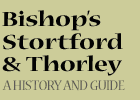

 Originally part of the medieval town this small thoroughfare is said to have once been called Dunghill Lane, the name supposedly given because dung carts from the market place parked here.
Originally part of the medieval town this small thoroughfare is said to have once been called Dunghill Lane, the name supposedly given because dung carts from the market place parked here. Understandably, the fires caused great alarm in the town, and on 6 April the town crier summoned vestry members to a parish meeting. A committee of eleven worthy citizens was formed and met daily with local magistrates. They organised a subscription whereby £500 was raised as a reward for information leading to a conviction, and a vigilante commission patrolled the town every night. No other fires were detected but on 10 April a threatening letter, written on cartridge paper and addressed to Joseph Taylor on the committe, was left at the North Street post office. It read thus:
Understandably, the fires caused great alarm in the town, and on 6 April the town crier summoned vestry members to a parish meeting. A committee of eleven worthy citizens was formed and met daily with local magistrates. They organised a subscription whereby £500 was raised as a reward for information leading to a conviction, and a vigilante commission patrolled the town every night. No other fires were detected but on 10 April a threatening letter, written on cartridge paper and addressed to Joseph Taylor on the committe, was left at the North Street post office. It read thus: